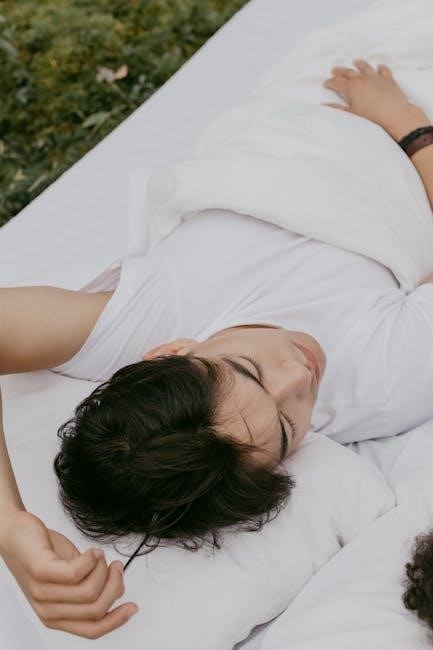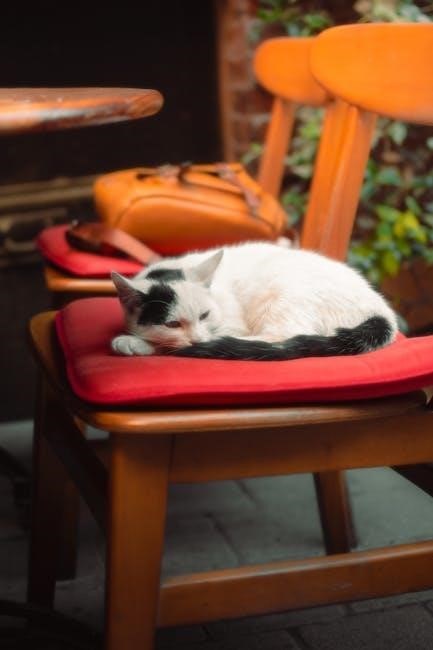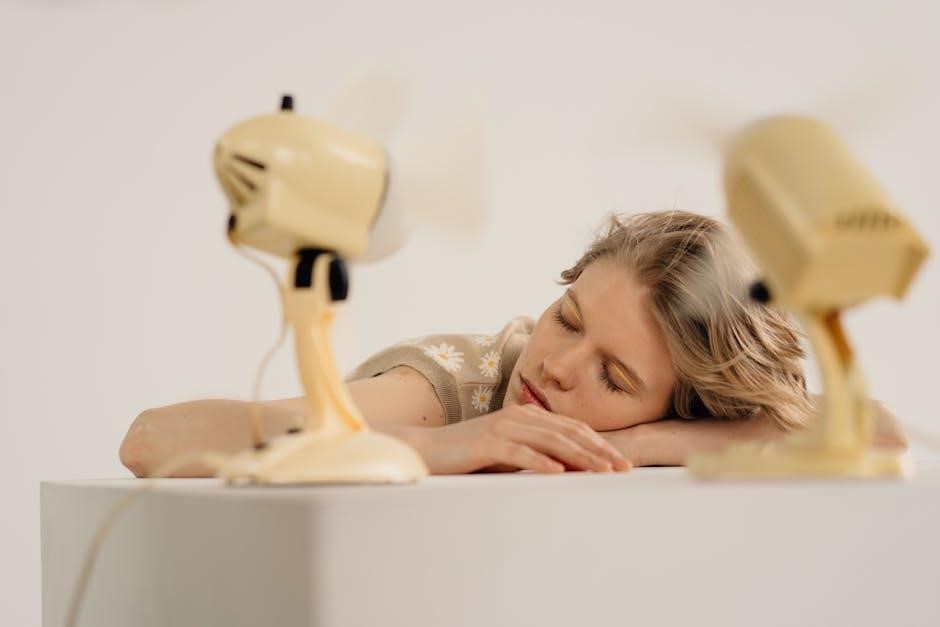A 1 Tog sleeping bag is ideal for spring and autumn, suitable for room temperatures between 18°C and 24°C. It provides balanced insulation, ensuring comfort without overheating, making it a versatile choice for seasonal transitions.
Tog ratings, or Thermal Overall Grade, measure the warmth and insulation of baby sleeping bags. This system helps parents choose the right sleeping bag based on room temperature, ensuring baby’s comfort and safety. A higher tog rating indicates greater warmth, suitable for colder environments, while lower ratings are ideal for warmer rooms. Understanding tog ratings is essential for maintaining a safe sleep environment and preventing overheating, which is a key factor in SIDS prevention. This guide explains how tog ratings work and how to use them effectively for your baby’s sleep.
What is a 1 Tog Sleeping Bag?
A 1 Tog sleeping bag is designed for moderate temperatures, typically between 18°C and 24°C. It offers lightweight insulation, making it perfect for spring and autumn nights. The 1 Tog rating ensures your baby stays warm without overheating, promoting a comfortable sleep environment. This tog level is ideal for rooms that are neither too hot nor too cold, providing just the right amount of warmth for seasonal transitions. It’s a popular choice for parents seeking a versatile sleeping solution during milder months.
Why Tog Ratings are Important for Baby Sleep
Tog ratings are crucial for ensuring your baby’s comfort and safety. They help you choose the right sleeping bag based on room temperature, preventing overheating or chilling. A 1 Tog bag is ideal for 18-24°C, while 0.5 Tog suits warmer rooms and 2.5 Tog colder ones. Proper tog selection reduces the risk of SIDS and ensures your baby sleeps comfortably. It also guides appropriate clothing layers, avoiding the dangers of over-dressing. By using the correct tog, you create a safe and cozy sleep environment tailored to your baby’s needs.

Understanding the 1 Tog Sleeping Bag
A 1 Tog sleeping bag is lightly padded, suitable for spring and autumn. It offers balanced insulation for room temperatures between 18°C and 24°C, preventing overheating.
Temperature Range for 1 Tog Sleeping Bags
A 1 Tog sleeping bag is designed for room temperatures between 18°C and 24°C, making it ideal for spring and autumn. It provides lightweight insulation, ensuring your baby stays comfortable without overheating. This range is perfect for seasonal transitions, offering just the right amount of warmth. Measure your nursery temperature accurately to ensure the 1 Tog rating is suitable. If the room is cooler, consider layering clothing appropriately to maintain your baby’s comfort and safety within the recommended temperature range.
Seasonal Appropriateness of 1 Tog Bags
A 1 Tog sleeping bag is best suited for spring and autumn, offering the perfect balance of warmth and breathability during milder seasons. It is ideal for room temperatures between 18°C and 24°C, making it a versatile choice for transitional weather. Avoid using it in extreme heat or cold, as it may not provide sufficient warmth in winter or could cause overheating in summer. This makes it a practical option for maintaining your baby’s comfort during the cooler parts of spring and autumn without compromising safety or comfort.
How to Measure Room Temperature for Tog Selection
To determine the appropriate Tog rating, accurately measure your baby’s room temperature using a digital thermometer. Place it away from drafts and windows, about 1 meter above the floor, to get an accurate reading. The ideal room temperature for babies ranges between 16°C and 20°C. Use this measurement to select the right Tog-rated sleeping bag, ensuring your baby stays comfortable and safe. Checking the temperature daily helps adjust bedding or clothing as needed, promoting a healthy sleep environment for your child.

Factors Influencing Tog Rating Choice
Room temperature, baby’s clothing, and seasonal changes are key factors in selecting the right Tog rating. These elements ensure your baby’s comfort and safety year-round.
Room Temperature and Its Impact
Room temperature significantly impacts the choice of Tog rating for a sleeping bag. A 1 Tog sleeping bag is suitable for rooms between 18°C and 24°C, ensuring optimal comfort. If the room is colder, a higher Tog rating may be necessary, while warmer rooms may require a lower Tog. Monitoring and adjusting based on room temperature helps maintain a safe and comfortable sleep environment for your baby, preventing overheating or chilling.
Baby’s Clothing and Layering
Baby’s clothing and layering play a crucial role in determining the appropriate Tog rating. A 1 Tog sleeping bag is designed to be used with lightweight clothing, such as a short-sleeved onesie or a thin sleeper. Overdressing can lead to overheating, while underdressing may result in the baby feeling cold. Proper layering ensures the baby’s comfort and safety, maintaining an ideal body temperature throughout the night. Always choose breathable fabrics and avoid adding extra blankets when using a sleeping bag.
Seasonal Variations and Tog Needs
Seasonal variations significantly influence the choice of Tog rating for baby sleeping bags. In warmer months, such as summer, a 0.5 Tog or lower rating is often sufficient, while colder seasons, like winter, may require a 2.5 Tog or higher. A 1 Tog sleeping bag is ideal for spring and autumn, where temperatures are mild and consistent. Parents should adjust the Tog rating based on their region’s climate and the baby’s comfort, ensuring optimal warmth without risking overheating. Seasonal adaptability is key to maintaining a safe and cozy sleep environment.
Seasonal Guidance for 1 Tog Sleeping Bags
A 1 Tog sleeping bag is perfect for spring and autumn, ideal in rooms between 18°C and 24°C. It balances warmth and breathability, ensuring comfort during mild seasons.
Spring and Autumn Usage
A 1 Tog sleeping bag is ideal for spring and autumn, offering the perfect balance of warmth and breathability. Suitable for room temperatures between 18°C and 24°C, it ensures your baby stays comfortable without overheating. During these seasons, the bag provides light insulation, making it versatile for cooler mornings and evenings. Its design allows for airflow, preventing moisture buildup and keeping your baby cozy throughout the night. This makes it a practical choice for transitional weather, adapting to fluctuating temperatures effortlessly.
Summer and Winter Alternatives
For summer, opt for a 0.5 Tog sleeping bag, designed for warmer temperatures above 24°C, ensuring lightweight breathability. In winter, switch to a 2.5 Tog bag for colder nights below 16°C, offering superior insulation. These alternatives provide tailored comfort for extreme seasons, while the 1 Tog remains ideal for mild conditions. Adjusting the Tog rating seasonally ensures your baby’s comfort and safety year-round, preventing overheating in summer and keeping them warm in winter.
Transitioning Between Seasons
Transitioning your baby between seasons with a 1 Tog sleeping bag requires careful monitoring of room temperature. As spring arrives, swap heavier winter blankets for the 1 Tog bag, ideal for 18-24°C. In autumn, it continues to provide consistent comfort. Adjust layering by adding or removing baby clothing as temperatures fluctuate. This ensures seamless adaptation to changing weather, maintaining your baby’s comfort and regulating their body temperature effectively throughout the seasonal shift without the need for drastic changes in sleeping arrangements.
Materials and Construction
1 Tog sleeping bags are crafted from lightweight, breathable materials like cotton or bamboo, ensuring thermal efficiency without overheating. The construction focuses on natural fibers for softness and moisture-wicking properties, maintaining comfort across temperatures.
Types of Materials Used in 1 Tog Bags
1 Tog sleeping bags are typically made from lightweight, breathable fabrics such as cotton, bamboo, or muslin. These materials are chosen for their softness, moisture-wicking properties, and ability to regulate body temperature. Synthetic blends are occasionally used for added durability while maintaining breathability. Natural fibers are preferred as they allow for better airflow, preventing overheating and ensuring the baby stays comfortable in temperatures between 18°C and 24°C. The choice of material directly impacts the bag’s thermal efficiency and overall safety.
Fill Power and Insulation Quality
Fill power in 1 Tog sleeping bags refers to the insulation material’s ability to trap air and provide warmth. Higher fill power generally means better insulation, but for a 1 Tog bag, a moderate level is sufficient. Common insulation materials include down or synthetic fibers, chosen for their breathability and moisture-wicking properties. Natural fibers are often preferred for their softness and ability to regulate temperature effectively. The insulation quality ensures the baby stays comfortable in temperatures between 18°C and 24°C without overheating, which is crucial for safety and preventing SIDS. Proper insulation also supports even heat distribution for optimal comfort.
Breathability and Moisture-Wicking Properties
Breathability and moisture-wicking properties are crucial for maintaining a baby’s comfort in a 1 Tog sleeping bag. High-quality materials, such as natural fibers like cotton or bamboo, allow air to circulate freely, preventing overheating. Moisture-wicking fabrics ensure sweat is drawn away from the skin, keeping the baby dry and comfortable. This is especially important for regulating body temperature and preventing skin irritation. Breathable materials also help reduce the risk of SIDS by ensuring the baby doesn’t overheat, while moisture-wicking properties maintain a dry environment, promoting safe and restful sleep.

Safety Considerations
Ensure your baby’s safety with a 1 Tog sleeping bag by following SIDS guidelines. Choose breathable, snug-fitting designs without loose threads or small parts that can pose risks.
SIDS Guidelines and Safe Sleep Practices
To ensure safe sleep, a 1 Tog sleeping bag should align with SIDS prevention guidelines. Opt for lightweight, breathable materials that prevent overheating. A snug fit is crucial to avoid slipping, while the neckline should be designed to prevent the bag from riding up. Avoid bags with hoods or attachments that could pose suffocation risks. Always place your baby on their back and keep the sleep environment free from loose bedding or soft toys. Prioritize a sleep bag made from natural, non-toxic fabrics for added safety and comfort.
Features to Look for in a Safe Sleeping Bag
When selecting a 1 Tog sleeping bag, prioritize safety and comfort. Look for breathable, lightweight materials that regulate body temperature and prevent overheating. Ensure a snug, ergonomic fit to avoid slipping or bunching. The neckline should be designed to prevent the bag from riding up, and the zipper or opening should be easy to use while keeping your baby secure. Opt for a sleeping bag with no hoods or loose attachments, and check for safety certifications. A safe sleeping bag promotes restful sleep while adhering to SIDS prevention guidelines.
Red Flags to Avoid in Sleeping Bags
When choosing a 1 Tog sleeping bag, avoid loose bedding, hoods, or bulky padding that could pose suffocation risks. Steer clear of oversized bags that may cause your baby to slip inside. Ensure there are no small, detachable parts that could be a choking hazard. Avoid materials that trap heat excessively, as they can lead to overheating. Additionally, check for proper zipper safety and ensure the bag doesn’t have any gaps that could expose your baby to cold air. Prioritize breathable fabrics and a snug, ergonomic design for optimal safety and comfort.
Comparisons with Other Tog Ratings
A 1 Tog sleeping bag offers moderate warmth, sitting between 0.5 Tog (lightweight for summer) and 2.5 Tog (thicker for colder winter nights). It’s ideal for mid-range temperatures, providing balanced insulation without overheating, making it versatile for seasonal transitions compared to other ratings.
0.5 Tog vs. 1 Tog: Key Differences
The 0.5 Tog sleeping bag is designed for warmer temperatures (above 24°C), offering minimal insulation, while the 1 Tog bag is suitable for spring and autumn (18-24°C). The 0.5 Tog is unlined and lightweight, ideal for summer nights, whereas the 1 Tog provides slightly more warmth with light padding. Choosing between them depends on room temperature and seasonal needs, ensuring the baby remains comfortable without overheating. The 1 Tog is a better option for cooler environments, while the 0.5 Tog is perfect for hotter conditions, making it essential to match the tog rating to the nursery’s climate for optimal comfort and safety.
1 Tog vs. 2.5 Tog: When to Upgrade
The 1 Tog and 2.5 Tog sleeping bags differ in warmth and suitability. A 1 Tog is ideal for temperatures between 18°C and 24°C, offering light insulation, while a 2.5 Tog is designed for colder conditions (below 16°C) with thicker padding. Upgrade to a 2.5 Tog during winter months or in colder rooms to ensure your baby stays warm. However, avoid using a 2.5 Tog in warmer environments to prevent overheating. The choice depends on room temperature and seasonal needs, ensuring your baby’s comfort and safety year-round.
How to Choose the Right Tog for Your Needs
Choosing the right Tog involves considering your baby’s room temperature, seasonal requirements, and their clothing. Measure the room temperature and match it to the Tog rating—1 Tog for 18-24°C, ideal for spring and autumn. If your baby feels cold in lighter clothing, opt for a higher Tog. For warmer rooms, a lower Tog or no sleeping bag may suffice. Adjust based on seasonal changes and your baby’s comfort, ensuring proper insulation without overheating. This balance ensures safe and cozy sleep, tailored to your baby’s unique needs and environmental conditions.
Practical Tips for Using a 1 Tog Sleeping Bag
Use a 1 Tog sleeping bag in rooms between 18-24°C, ideal for spring and autumn. Dress your baby in lightweight layers to maintain comfort and prevent overheating.
How to Dress Your Baby for 1 Tog
For a 1 Tog sleeping bag, dress your baby in lightweight, breathable clothing suitable for room temperatures between 18-24°C. Start with a short-sleeved onesie or bodysuit as a base layer, then add a thin cotton top. Avoid using hats or bulky clothing, as this can cause overheating. Check your baby’s comfort regularly by feeling their chest or back. Adjust layers if needed to ensure they’re neither too hot nor too cold. This approach ensures optimal comfort and safety while using the 1 Tog sleeping bag.
Monitoring Your Baby’s Comfort
Regularly check your baby’s comfort while using a 1 Tog sleeping bag. Look for signs of overheating, such as sweating, flushed skin, or restlessness. Feel their chest or back through the fabric to ensure they’re not too warm. If the room temperature fluctuates, adjust layers accordingly. Use a room thermometer to maintain the ideal range of 18-24°C. Avoid over-bundling, as this can lead to discomfort and disrupted sleep. Monitoring ensures your baby stays safe and cozy, making the most of the 1 Tog sleeping bag’s versatility;
Adjusting for Different Room Conditions
Adapt your baby’s sleep setup based on room temperature changes. For cooler rooms, layer with lightweight clothing like a onesie or sleepsuit. In warmer rooms, remove extra layers to prevent overheating. Use a room thermometer to ensure the environment stays within the 18-24°C range for a 1 Tog sleeping bag. Adjustments help maintain comfort and prevent sleep disruptions. Regular checks ensure your baby stays cozy without risking overheating, promoting safe and restful sleep regardless of seasonal changes.

Caring for Your 1 Tog Sleeping Bag
Wash in mild detergent, dry flat to maintain insulation. Store in a cool, dry place when not in use to preserve quality and tog rating.
Washing and Drying Instructions
Wash your 1 Tog sleeping bag in a gentle cycle using a mild detergent. Avoid bleach or fabric softeners to preserve the material. Tumble dry on a low setting or air dry to maintain insulation quality. Remove promptly after drying to prevent wrinkling. Store flat or hang to keep the shape intact. Regular washing helps maintain hygiene without compromising the tog rating, ensuring your baby’s comfort and safety. Always follow the manufacturer’s care label for specific instructions.
Storing the Sleeping Bag When Not in Use
Store the 1 Tog sleeping bag in a cool, dry place to maintain its quality. Use a breathable storage bag or a cotton pillowcase to prevent moisture buildup. Avoid plastic bags, as they can trap humidity and damage the material. Ensure the bag is clean and completely dry before storing to prevent mildew. Do not compress the sleeping bag for extended periods, as this can reduce its insulation properties. Proper storage helps preserve the tog rating and ensures the sleeping bag remains effective for future use.
Maintaining the Tog Rating Over Time
To preserve the 1 Tog rating, wash the sleeping bag gently with a mild detergent and avoid fabric softeners, which can reduce insulation. Air-dry the bag away from direct sunlight to prevent fading and damage to the materials. Avoid using tumble dryers, as high heat can degrade the insulation. Store the bag in a breathable container to maintain its thermal properties. Regularly inspect for wear and tear, and repair any damage promptly. Avoid compressing the bag for extended periods, as this can compromise its loft and insulation efficiency. Proper care ensures the tog rating remains consistent over time.
Troubleshooting Common Issues
Address overheating by adjusting layers or switching to a lower tog bag. For cold issues, add a lightweight blanket or opt for a higher tog rating. Ensure proper room temperature measurement for accurate tog selection to maintain comfort and safety. Regularly monitor baby’s comfort and adjust as needed.
What to Do If Your Baby is Too Hot
If your baby feels too hot in their 1 Tog sleeping bag, check the room temperature. Ensure it’s within the recommended range (18-24°C); Remove excess layers of clothing and consider switching to a lighter tog rating. Avoid overdressing, as this can cause overheating. Ensure the sleeping bag is breathable and moisture-wicking to regulate body temperature. Monitor your baby for signs of discomfort, such as sweating or restlessness. Adjust their clothing or environment as needed to maintain a comfortable sleep environment and prevent overheating.
What to Do If Your Baby is Too Cold
If your baby feels too cold while using a 1 Tog sleeping bag, ensure the room temperature is within the recommended range (18-24°C). Check if the room is too chilly and adjust the heating if necessary; Consider adding a lightweight layer of clothing, such as a sleep suit, to provide extra warmth. Avoid using blankets, as they can pose a safety risk. Ensure the sleeping bag is designed for colder conditions and made from breathable, insulating materials. Monitor your baby’s comfort and adjust their clothing or environment as needed to maintain a cozy sleep environment.
Addressing Sleep Disruptions
Sleep disruptions in babies can often be linked to discomfort or environmental factors. Ensure the room temperature aligns with the 1 Tog sleeping bag’s range (18-24°C) to prevent overheating or chilling. Check for drafts or noise that might disturb your baby. A consistent bedtime routine can help signal sleep time, reducing resistance. If your baby is restless, inspect the sleeping bag for proper fit and comfort. Signs of overtiredness or overstimulation may require calming techniques, such as gentle rocking or soothing music. A peaceful sleep environment is key to uninterrupted rest.
A 1 Tog sleeping bag offers balanced insulation for spring and autumn, ensuring comfort in temperatures between 18°C and 24°C. It promotes safe sleep and proper temperature regulation for your baby’s well-being.
Final Thoughts on 1 Tog Sleeping Bags
A 1 Tog sleeping bag is an excellent choice for spring and autumn, offering the right amount of insulation for room temperatures between 18°C and 24°C. It ensures your baby stays comfortable without overheating, making it a practical option for seasonal transitions. By considering room temperature and your baby’s clothing, you can create a safe sleep environment. Always prioritize proper fit and safety features to promote healthy sleep habits and peace of mind for parents.
Encouragement to Prioritize Safety
Prioritizing safety is paramount when using a 1 Tog sleeping bag. Ensure the bag fits properly, avoiding loose fabric that could pose suffocation risks. Dress your baby in lightweight, breathable clothing suitable for the room temperature. Always follow SIDS guidelines, keeping the sleep environment free from hazards like loose bedding or toys. Regularly monitor your baby’s comfort and adjust as needed. By adhering to safety practices, you can create a secure and comfortable sleep environment, giving you peace of mind while promoting healthy sleep habits for your child.
Importance of Proper Temperature Regulation
Proper temperature regulation is crucial for your baby’s comfort and safety. A 1 Tog sleeping bag is designed for rooms between 18°C and 24°C, ensuring your baby stays warm without overheating. Overheating can increase the risk of SIDS, making it essential to maintain a safe temperature range. Dress your baby in lightweight clothing and monitor their comfort. This balance prevents discomfort and potential dangers, promoting a safe and restful sleep environment.
Additional Resources
Explore reputable parenting websites, baby safety organizations, and manufacturer guides for detailed 1 Tog sleeping bag information and temperature regulation tips.
Recommended Reading for Parents
Parents can find valuable insights in baby care books, online forums, and official health websites. Reputable sources like the NHS, baby safety organizations, and parenting blogs offer detailed guides on tog ratings, room temperature management, and safe sleep practices. These resources provide evidence-based advice, helping parents make informed decisions about their baby’s sleep environment. Additionally, manufacturer websites often include care guides and sizing charts for 1 Tog sleeping bags, ensuring optimal comfort and safety for your child.
Where to Find More Information
For additional insights, visit reputable sources like the NHS, baby safety organizations, and parenting blogs. Websites specializing in baby sleep products often provide detailed guides. Manufacturer sites, such as Slumbersac, offer comprehensive information on tog ratings and seasonal usage. Online forums and communities, like netmums or Mumsnet, share real-parent experiences and recommendations. Libraries and bookstores may carry baby care books with sections on sleep safety and tog-rated bedding. These resources ensure you’re well-informed to make the best choices for your baby’s comfort and safety.
Community Support and Forums
Online communities and forums are invaluable for discussing baby sleep solutions. Platforms like Mumsnet and netmums host threads where parents share experiences with 1 Tog sleeping bags. These forums offer practical tips, product recommendations, and advice on maintaining optimal room temperatures. Experienced parents often provide insights on layering clothing and seasonal transitions. Additionally, specialized baby care groups on social media platforms like Facebook and Reddit can connect you with others facing similar challenges. These communities foster support and provide reassurance, helping you make informed decisions for your baby’s comfort and safety.
